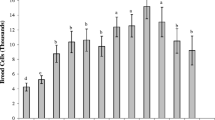Abstract
In-vitro reared drone larvae of several sister queens from an Apis mellifera ligustica and a Buckfast breeding line were infected with Paenibacillus larvae (type strain ATCC 9545) causing American foulbrood (AFB). Although drone larvae were susceptible to AFB and could be infected under in-vitro conditions there were differences within and between lineages. Infection sensitivity was higher in the A. m. ligustica line compared to the Buckfast line. Different infection thresholds were found among sister queens of the A. m. ligustica line suggesting a considerable genetic variance for larval resistance against AFB.
Zusammenfassung
Drohnenlarven von Schwesterköniginnen einer Buckfast und einer Apis mellifera ligustica Brutlinie wurden mit Sporen eines Bakterien-Typstammes von Paenibacillus larvae, dem Erreger der Amerikanischen Faulbrut (AFB), einer schweren Brutkrankheit der Honigbiene, infiziert. Die Sterblichkeit der Larven wurde täglich in nicht-infizierten Kontrollen und der sporenbehandelten Gruppe aufgenommen. Die Larven wurden unter kontrollierten in-vitro Bedingungen aufgezogen, um alle Faktoren auszuschließen, die bekanntermaßen AFB Resistenz auf Kolonieebene beeinflussen (z.B. hygienisches Verhalten, Futterkomponenten). Larven der untersuchten Königinnen der Buckfastlinie waren bei den untersuchten Sporendosen weniger anfällig als Nachkommen der Apis mellifera ligustica Linie (Abb. 1). Dies zeigt, dass in verschiedenen Honigbienenlinien unterschiedliche Resistenzniveaus existieren. Wir können allerdings nicht sagen, ob die gefundenen Resistenzniveaus repräsentativ für alle Buckfast bzw. Apis mellifera ligustica Linien sind und ob sie auch konsistent für andere Bakterienstämme wären. Innerhalb der A. m. ligustica Linie fanden wir eine Varianz für Infektionsgrenzwerte (Abb. 2). Dies zeigt, dass diese Grenzwerte auch genetisch beeinflusst sein können. Zusätzlich wurde eine Methode entwickelt, um Varianz in larvaler Resistenz gegen AFB zu bestimmen, unter Benutzung haploider Drohnenlarven.
Similar content being viewed by others
References
Burnside C.E., Sturtevant A.P., Holst E.C. (1949) Diagnosing bee diseases in the apiary, US Dept. Agric. Circ. 392, 31 p.
Evans J.D. (2004) Transcriptional immune responses by honey bee larvae during invasion by the bacterial pathogen, Paenibacillus larvae, J. Invertebr. Pathol. 85, 105–111.
Evans J.D., Pettis J.S. (2005) Colony-level impacts of immune responsiveness in honey bees, Apis mellifera, Evolution 59, 2270–2274.
Fries I., Camazine S. (2001) Implications of horizontal and vertical pathogen transmission for honey bee epidemiology, Apidologie 32, 199–214.
Fries I., Lindström A., Korpela S. (2006) Vertical transmission of American foulbrood (Paenibacillus larvae) in honey bees (Apis mellifera), Vet. Microbiol. 114, 269–274.
Gehan E.A. (1969) Estimating survival functions from the life table, J. Chronic Dis. 21, 629–644.
Genersch E., Ashiralieva A., Fries I. (2005) Strain- and genotype-specific differences in virulence of Paenibacillus larvae subsp. larvae, a bacterial pathogen causing American foulbrood disease in honeybees, Appl. Environ. Microbiol. 71, 7551–7555.
Genersch E., Forsgren E., Pentikainen J., Ashiralieva A., Rauch S., Kilwinski J., Fries I. (2006) Reclassification of Paenibacillus larvae subsp. pulvifaciens and Paenibacillus larvae subsp. larvae as Paenibacillus larvae without subspecies differentiation, Int. J. Syst. Evol. Microbiol. 56, 501–511.
Hansen H., Brødsgaard C.J. (1999) American foulbrood: a review of its biology, diagnosis and control, Bee World 80, 5–23.
Haseman L. (1961) How long can spores of American foulbrood live? Am. Bee J. 101, 298–299.
Jay S.C. (1963) The development of honeybees in their cells, J. Apic. Res. 2, 117–134.
Nordström S., Fries I. (1995) A comparison of media and cultural conditions for identification of Bacillus larvae in honey, J. Apic. Res. 34, 97–103.
Palmer K.A., Oldroyd B.P. (2003) Evidence for intra-colonial genetic variance in resistance to American foulbrood of honey bees (Apis mellifera): further support for the parasite/pathogen hypothesis for the evolution of polyandry, Naturwissenschaften 90, 265–268.
Peng Y.S.C., Müssen E., Fong A., Montague M.A., Tyler T. (1992) Effects of chlortetracycline of honeybee worker larvae reared in vitro, J. Invertebr. Pathol. 60, 127–133.
Rinderer T.E., Rothenbuhler W.C. (1974) The influence of pollen on the susceptibility of honey-bee larvae to Bacillus larvae, J. Invertebr. Pathol. 23, 347–350.
Rose R.I., Briggs J.D. (1969) Resistance to American foulbrood in honeybees. IX. Effects of honeybee larval food on the growth and viability of Bacillus larvae, J. Invertebr. Pathol. 13, 74–80.
Rothenbuhler W.C. (1958) Genetics and breeding of honeybee, Annu. Rev. Entomol. 3, 161–180.
Rothenbuhler W.C., Thompson V.C. (1956) Resistance to American foulbrood in honeybees. I. Differential survival of larvae of different genetic lines, J. Econ. Entomol. 49, 470–475.
Spivak M., Gilliam M. (1998a) Hygienic behaviour of honeybees and its application for control of brood diseases and varroa. Part I. Hygienic behaviour and resistance to American foulbrood, Bee World 79, 124–134.
Spivak M., Gilliam M. (1998b) Hygienic behaviour of honeybees and its application for control of brood diseases and varroa. Part II. Studies on hygienic behaviour since the Rothenbuhler era, Bee World 79, 169–186.
Sturtevant A.P. (1932) Relation of commercial honey to the spread of American foulbrood, J. Agric. Res. 45, 257–285.
Sturtevant A.P., Revell I.L. (1953) Reduction of Bacillus larvae spores in liquid food of honeybees by action of the honey stopper, and its relation to the development of American foulbrood, J. Econ. Entomol. 46, 855–860.
Woodrow A.W., Holst E.C. (1942) The mechanism of colony resistance to American foulbrood, J. Econ. Entomol. 35, 327–330.
Author information
Authors and Affiliations
Corresponding author
Additional information
Manuscript editor: Maria Spivak
Rights and permissions
About this article
Cite this article
Behrens, D., Forsgren, E., Fries, I. et al. Infection of drone larvae (Apis mellifera) with American foulbrood. Apidologie 38, 281–288 (2007). https://doi.org/10.1051/apido:2007009
Received:
Revised:
Accepted:
Issue Date:
DOI: https://doi.org/10.1051/apido:2007009




